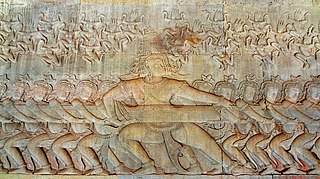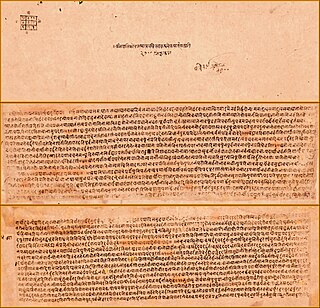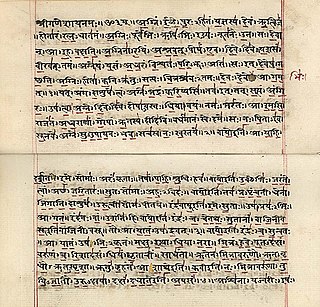Related Research Articles

Indra is the king of the devas (deities) and Svarga (heaven) in Hinduism. He is associated with the sky, lightning, weather, thunder, storms, rains, river flows, and war. Indra's powers are similar to other Indo-European deities such as Norse Odin, Jupiter, Perun, Perkūnas, Zalmoxis, Taranis, Zeus, and Thor, part of the greater Proto-Indo-European mythology.

Asuras are a class of beings in Indic religions. They are described as power-seeking demons related to the more benevolent Devas in Hinduism. In its Buddhist context, the word is sometimes translated "titan", "demigod", or "antigod".

An apsaras or apsara is a member of a class of celestial beings in Hindu and Buddhist culture. They are originally a type of female spirit of the clouds and waters, who later plays the role of a "nymph" or "fairy". They figure prominently in the sculpture, dance, literature and painting of many South Asian and Southeast Asian cultures.
In the Vedic tradition, sóma is a ritual drink of importance among the early Vedic Indo-Aryans. The Rigveda mentions it, particularly in the Soma Mandala. Gita mentions the drink in chapter 9. It is equivalent to the Iranian haoma.

Chandra, also known as Soma, is the Hindu god of the Moon, and is associated with the night, plants and vegetation. He is one of the Navagraha and Dikpala.

In Indian religions, a rishi is an accomplished and enlightened person. They find mentions in various Vedic texts. Rishis are believed to have composed hymns of the Vedas. The Post-Vedic tradition of Hinduism regards the rishis as "great yogis" or "sages" who after intense meditation (tapas) realized the supreme truth and eternal knowledge, which they composed into hymns. The term appears in Pali literature as Ishi and in Buddhism, they can be either Buddhas, Paccekabuddhas, Arahats or a monk of high rank.
Savitṛ, also rendered as Savitur, in Vedic scriptures is an Aditya i.e. off-spring of the Vedic primeval mother goddess Aditi. His name in Vedic Sanskrit connotes "impeller, rouser, vivifier."
Saṃhitā literally means "put together, joined, union", a "collection", and "a methodically, rule-based combination of text or verses". Saṃhitā also refers to the most ancient layer of text in the Vedas, consisting of mantras, hymns, prayers, litanies and benedictions.
Dasa is a Sanskrit word found in ancient Indian texts such as the Rigveda, Pali canon, andArthasastra. The term may mean "enemy" or "servant," but Dasa or Das can also have the following connotations: "servant of God", "devotee," "votary" or "one who has surrendered to God." Dasa may be a suffix of a given name to indicate a "servant" of a revered person or a particular deity.
Kriyā most commonly refers to a "completed action", technique or practice within a yoga discipline meant to achieve a specific result.

Deva means "shiny", "exalted", "heavenly being", "divine being", "anything of excellence", and is also one of the Sanskrit terms used to indicate a deity in Hinduism. Deva is a masculine term; the feminine equivalent is Devi. The word is a cognate with Latin deus ("god") and Greek Zeus.

The Vedas are a large body of religious texts originating in ancient India. Composed in Vedic Sanskrit, the texts constitute the oldest layer of Sanskrit literature and the oldest scriptures of Hinduism.
Aryaman is one of the early Vedic Hindu deities. His name signifies "Life-Partner", "close friend", "Partner", "play-fellow" or "companion". He is the third son of Kashyapa and Aditi, the father and mother of the adityas, and is depicted as the mid-morning sun disc. He is the deity of customs, and rules over the customs that rule the various Vedic tribes and people.

Vishvakarma or Vishvakarman is a craftsman deity and the divine architect of the devas in contemporary Hinduism. In the early texts, the craftsman deity was known as Tvastar and the word "Vishvakarma" was originally used as an epithet for any powerful deity. However, in many later traditions, Vishvakarma became the name of the craftsman god.

Nirukta is one of the six ancient Vedangas, or ancillary science connected with the Vedas – the scriptures of Hinduism. Nirukta covers etymology, and is the study concerned with correct interpretation of Sanskrit words in the Vedas.
In Hindu mythology, Sarama is a mythological dog being referred to as the female dog of the gods, or Deva-shuni. She first appears in one of Hinduism's earliest texts, the Rig Veda, in which she helps the king of the gods Indra to recover divine cows stolen by the Panis asuras. This legend is alluded to in many later texts, and Sarama is often associated with Indra. The epic Mahabharata, and some Puranas, also make brief reference to Sarama.
In Hinduism, Rishabha is one of the twenty-four avatars of Vishnu in the Bhagavata Purana. Some scholars identify this avatar to be the same as the first tirthankara of Jainism, Rishabhanatha. Shaiva texts like the Linga Purana regard Rishabha to be among the 28 avatars of Shiva. Rishabha is also found in Vedic literature, where it means the "bull" and is an epithet for Rudra (Shiva).
Originating in historical Vedic religion, 'Pravargya', also known as 'Ashvina-pravaya', is an introductory or preliminary ceremony to the Soma Yajña.
Vīrya literally means "state of a strong man" or "manliness." In Hindu Vedic literature, the term is often associated with heroism and virility. In Brahmacharya in Hinduism, Virya also refers to semen in a male and it is considered to be the 'vital fluid'. Loss of Virya from the body is avoided in Brahmacharya.

The Rigveda or Rig Veda is an ancient Indian collection of Vedic Sanskrit hymns (sūktas). It is one of the four sacred canonical Hindu texts (śruti) known as the Vedas. Only one Shakha of the many survive today, namely the Śakalya Shakha. Much of the contents contained in the remaining Shakhas are now lost or are not available in the public forum. Rigveda Samhita was composed in the northwestern region of the Indian subcontinent.
References
- ↑ "Rig Veda: Rig-Veda, Book 8: HYMN XXXII. Indra".
- ↑ Živković, Marko (2011). Serbian Dreambook: National Imaginary in the Time of Milošević.
- ↑ Wüst, Walther (1934). Die indogermanischen Bestandteile des Rigveda und das Problem der "urindischen" Religion.
- ↑ Williams, Monier (1872). A Sanskrit-English Dictionary: Etymologically and philologically arranged with special reference to Greek, Latin, Gothic, German, Anglo-Saxon, and other cognate Indo-European Languages By Monier Williams. At the Clarendon Press Sold by Macmillan.
- ↑ Rudnicki, Mikołaj (1959). Prasłowiańszczyzna, Lechia-Polska (in Polish). Państwowe wydawn. naukowe, Oddzia ︢w Poznaniu. p. 182.
- ↑ Gluhak, Alemko (1993). Hrvatski etimološki rječnik[Croatian etymological dictionary] (in Croatian). Zagreb: August Cesarec. pp. 573–574. ISBN 953-162-000-8.